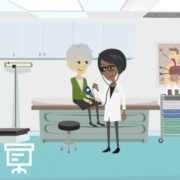How to Make an Informed MPN Treatment Decision
How to Make an Informed MPN Treatment Decision from Patient Empowerment Network on Vimeo.
When faced with several options, how can you decide on the best therapy for your essential thrombocythemia (ET), polycythemia vera (PV), or myelofibrosis (MF)? In this explainer video, Katrina and her doctor walk through important considerations when choosing treatment and provide advice for partnering with your healthcare team.
Related Programs:

What’s YOUR Role in Making Myelofibrosis Treatment Decisions? |

|

COVID-19 Vaccination: What Do Myelofibrosis Patients Need to Know? |
Transcript:
Katrina:
Hi, I’m Katrina. Nice to meet you!
Several years ago, I started having headaches and felt very tired. After a trip to the doctor and undergoing bloodwork, I was diagnosed with polycythemia vera, or PV, which is a rare blood cancer that causes my body to produce too many blood cells. It was overwhelming at the time to learn that I had a blood cancer, but my hematologist, Dr. Liu, told me more about the condition and how it’s managed.
Here’s Dr. Liu–she can explain it further.
Dr. Liu:
Hi! I’m Dr. Liu, and I’m a hematologist specializing in the care and treatment of people with myeloproliferative neoplasms or MPNs. MPNs are a group of blood cancers that are characterized by the bone marrow overproducing a certain type of cell. Katrina was diagnosed with PV, which is one of the three MPNs. The three types of MPNs are:
Essential thrombocythemia, or ET, which means that the body is producing too many platelets. The second is polycythemia vera or PV. PV is characterized by the overproduction of red blood cells, and, in some cases, elevated white blood cells and platelets. And the third is myelofibrosis or MF, which causes scarring in the bone marrow that disrupts the normal production of blood cells.
When a patient is diagnosed with any of these conditions, there is a chance they could progress from one condition to the next.
Those that have been diagnosed with ET, PV or MF, should have regular visits with their hematologist to monitor their condition and find the most appropriate treatment to manage their MPN.
Katrina:
After I was diagnosed, I met with Dr. Liu and she walked me through the goals of treatment for PV.
Dr. Liu:
Right! First, we talked about the clinical goals of treatment for PV, which are to reduce the risk of a blood clot and ease or eliminate any symptoms.
And, it’s important to note that because each of the MPNs is different, they are treated differently – be sure to discuss the specific goals of YOUR MPN with your doctor.
Katrina and I reviewed the effectiveness of each treatment option, including how treatment would be administered, and took all of her test results into consideration to make sure we found the best, most personalized treatment option for her PV. Then, we went over what our next steps would be if the treatment plan needed to be adjusted.
Katrina:
Next, we talked about another key treatment goal: symptom management. Dr. Liu let me know that I should make her aware of any symptoms that I may be having, even if I don’t think it’s related to my PV.
Dr. Liu:
Exactly, Katrina. A significant change in symptoms can indicate that it may be time to switch treatments or that the disease might be changing. Those symptoms may include enlarged spleen, fever, itching, fatigue and anemia, among others. This is why it’s always important to not only have blood counts checked regularly, but it’s essential to tell your doctor or nurse about any symptoms you may be having, even if you don’t think it’s related to your MPN.
And, last but not least, we discussed the most important treatment goal: Katrina’s goals. Katrina let me know that she’s very social and enjoys playing golf and tennis with her friends – we wanted to make sure she could continue doing the activities she loves.
Katrina:
Dr. Liu reviewed each of the treatment approaches with me, including potential side effects for every therapy and how it could impact my lifestyle. We discussed the pros and cons of each option, together.
Dr. Liu:
Exactly! When deciding on therapy, you and your doctor may also consider:
Your age and overall health, any presence or history of other medical problems, and the financial impact of a treatment plan.
Katrina:
In addition to asking questions, my daughter, Sarah, took notes during our appointments, since it was often hard for me to absorb everything at once.
We also made sure to talk about the appointment on our way home, while the information was fresh on our minds. And we did our part by researching PV and bringing a list of questions to each appointment.
Sarah found an office visit planner on the Patient Empowerment Network website that helped me organize my health info and questions.
Dr. Liu:
As you can see, Katrina and her daughter were actively engaged in each care decision. It’s vital that patients feel empowered to speak up. If you can, bring a friend or loved one along to your appointment.
And, if you are able, it’s a good idea to seek a second opinion or a consultation with an MPN specialist to help you feel confident in your care decisions.
Katrina:
Dr. Liu let me know that she would monitor my condition through regular physical exams, blood work and frequent communication. She made Sarah and I feel included in the decision-making process, as if it were a collaboration.
Dr. Liu:
That’s right. This is a partnership. So, what steps can you take to be more engaged in your MPN care?
- Bring a friend or loved one to your appointments.
- Understand and articulate the goals of your treatment plan.
- Learn about your options and weigh the pros and cons of each approach.
- Consider a second opinion or a consult with a specialist.
Katrina:
That’s great advice, Dr. Liu. To learn more, visit powerfulpatients.org/MPN to access a library of tools.
Thanks for joining us!










